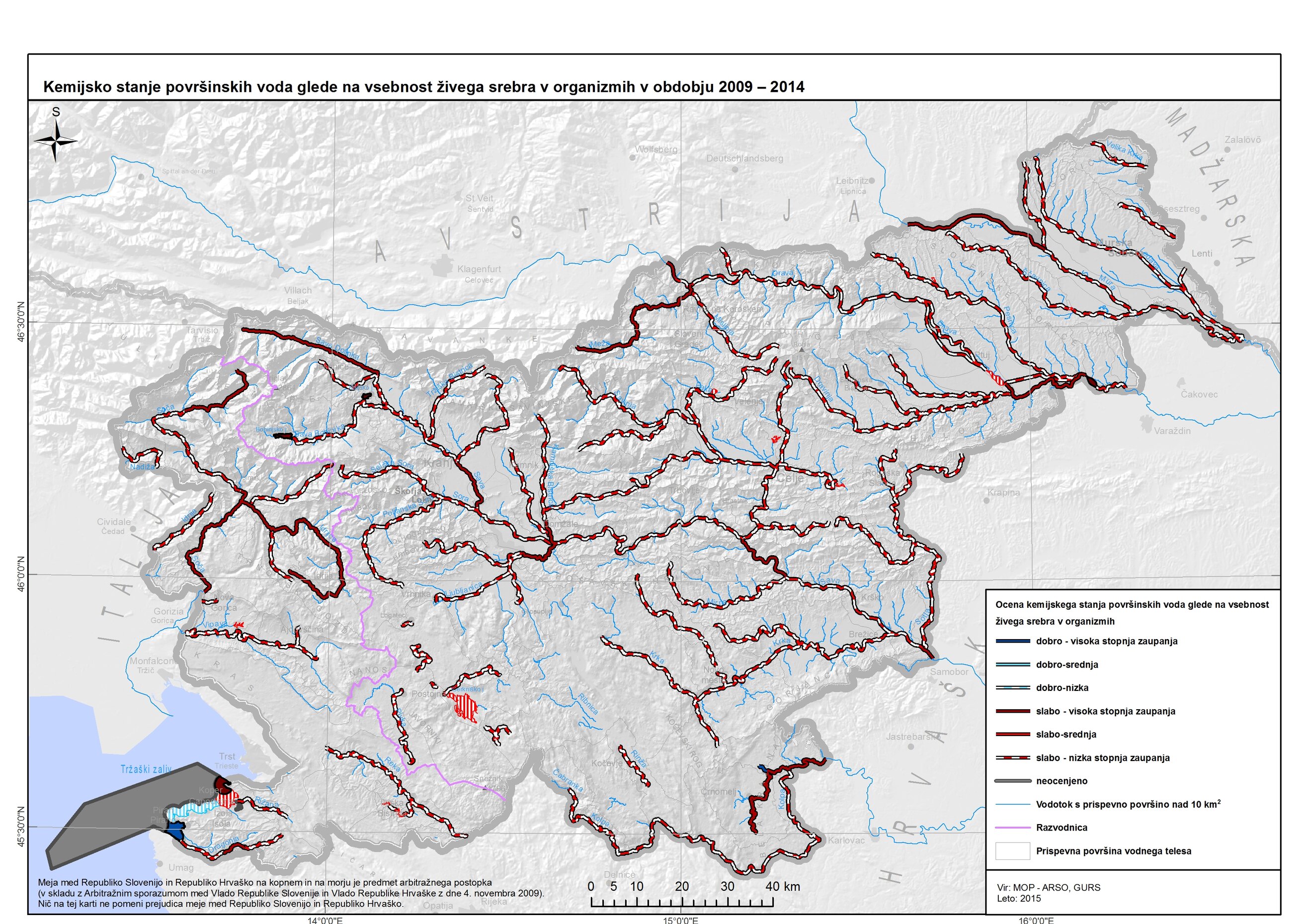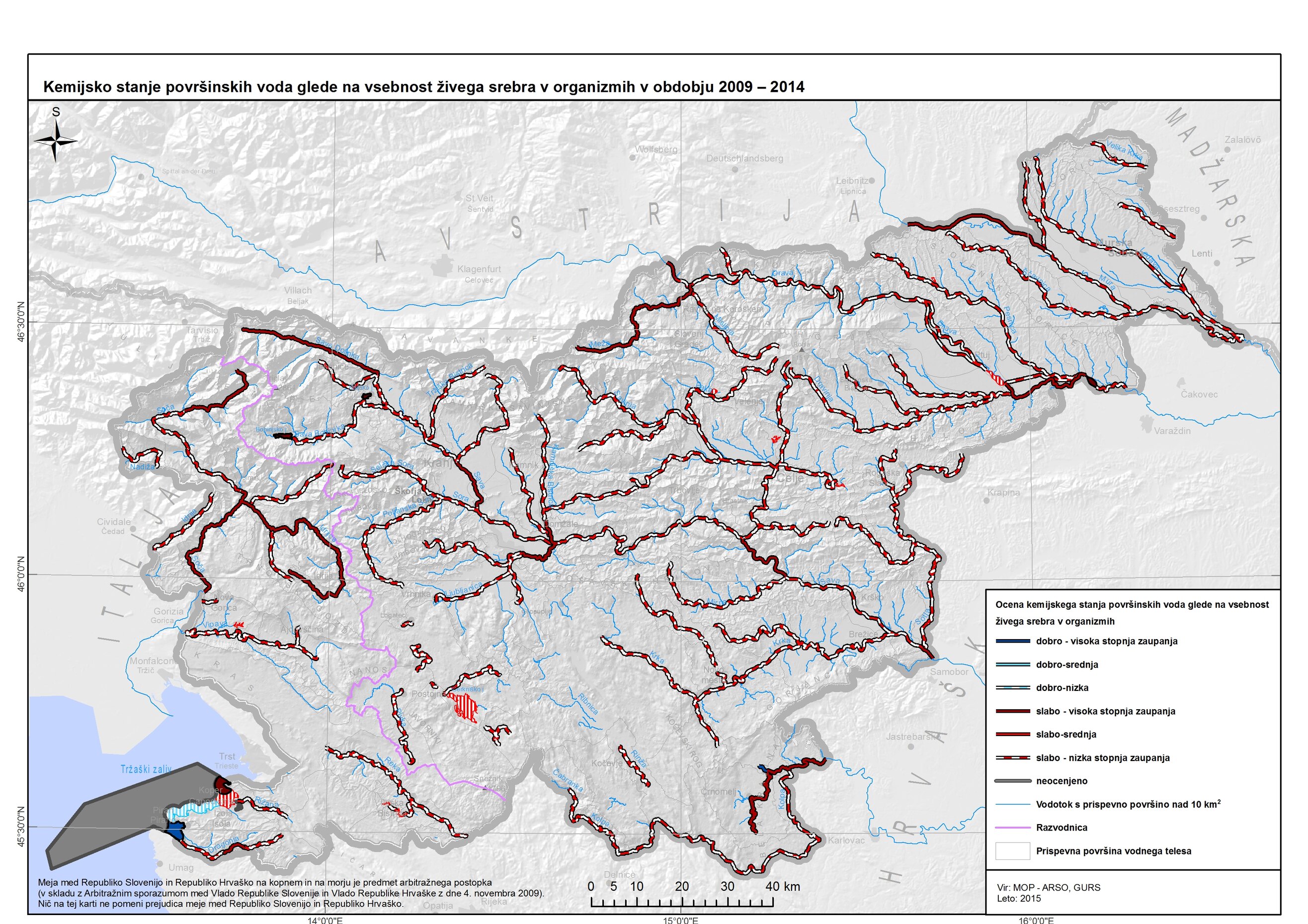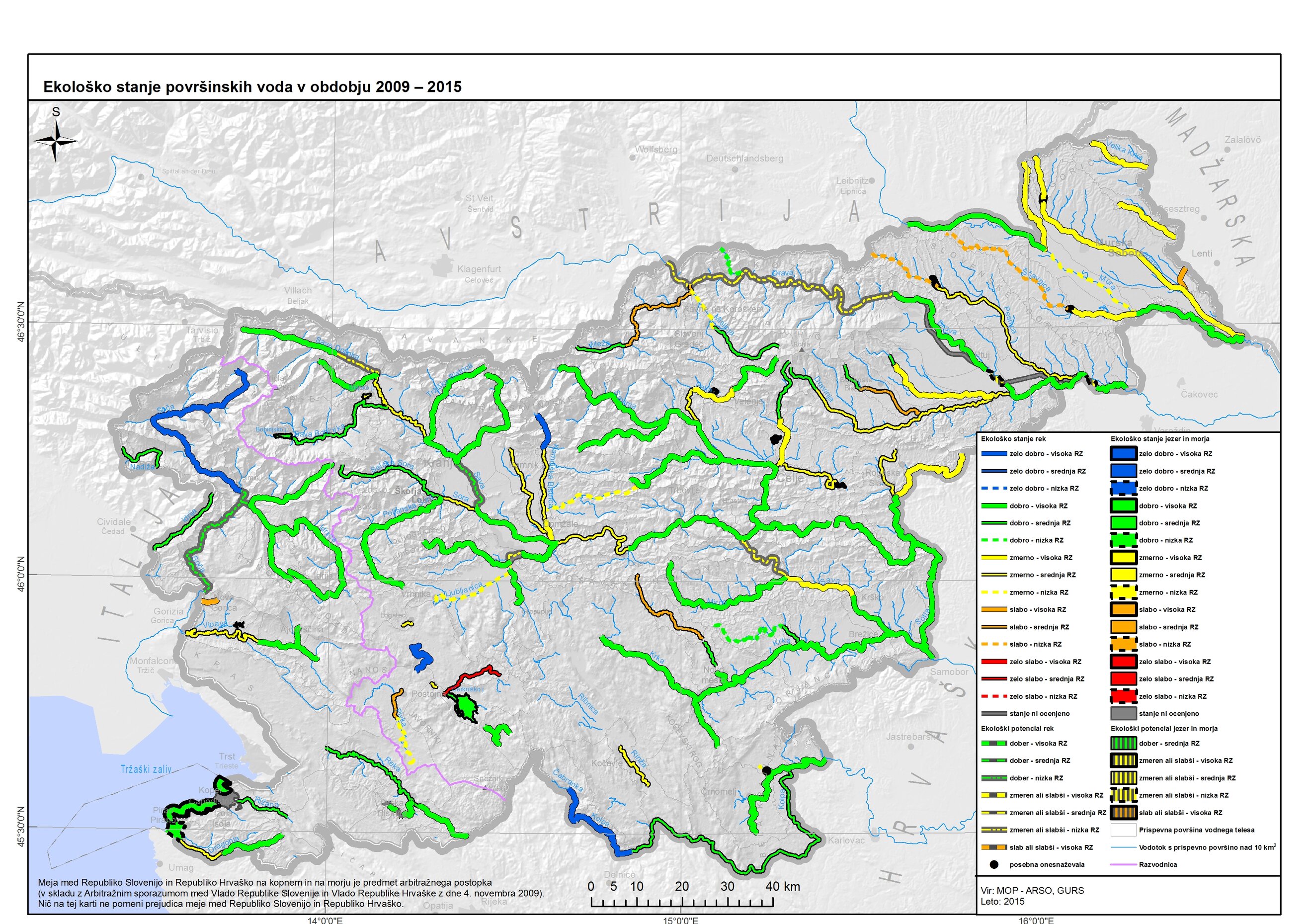[VD12] Chemical and ecological status of surface water bodies

Key message

A good chemical state was established in 96% of surface water bodies, while poor chemical states were established in five marine water bodies due to tributyltin compounds. Generally, Slovenian surface waters are not polluted with priority or priority hazardous substances. In the 2009–2015 period, 59% of water bodies were estimated to be in good ecological state. Hydromorphological changes and general degradation are the main reasons for moderate or low ecological state of surface waters. In comparison with previous periods, the share of water bodies classified as being in good ecological state has increased by 6%.
Definition
This indicator presents the assessed chemical and ecological state of surface waters in accordance with the criteria of the Water Framework Directive (2000/60/EC). The estimate includes all inland surface water bodies, transitional (brackish) water bodies and coastal seawater bodies, while in respect of chemical state, territorial seawater is also included. The basic assessment unit is a water body, which is a discrete and significant element of surface water, such as a lake, reservoir, stream, river or canal, part of a stream, river or canal or a stretch of coastal water. In Slovenia, 155 water bodies were identified in accordance with the Rules on determining and classification for water bodies on surface water (Official Gazette of the Republic of Slovenia, Nos. 63/05, 26/06, 32/11). Pursuant to the Water Framework Directive, assessments of chemical and ecological state of water bodies are conducted for multi-year periods. This indicator presents assessments for the periods 2006–2008 and 2009–2015.
Chemical state
The chemical state presents the rate of pollution of surface waters expressed as the content of priority and priority hazardous substances for which uniform quality standards have been set on the territory of the European Union Member States. Thousands of various chemicals are being released into the water environment and at the European level. Thirty-three were classified as priority substances or groups of substances. These substances were selected as relevant for the territory of all EU countries due to their widespread use and their elevated concentrations in surface waters. These substances include e.g. atrazine, benzene, cadmium, mercury, carbon tetrachloride, etc. The chemical state of surface waters is assessed using a two-level scale: good or poor.
Ecological state
The ecological state of water is an expression of the quality of the structure and functioning of aquatic ecosystems associated with surface waters. In assessing the ecological state, biological quality elements (water plant communities, algae, fish and invertebrates) are relevant. The state of these elements is used to assess various loads. The trophical state of aquatic ecosystems is assessed by examining aquatic plant communities and algae (nutrient loading); algae and benthic invertebrates are used to assess the saprobic quality of aquatic ecosystems (the level of pollution with organic substances), while benthic invertebrates and fish are used to assess hydromorphological changes and general degradation of aquatic ecosystems. Assessment of the ecological state of the water also takes account of general physical and chemical elements (content of nutrients and organic matter), hydromorphological elements (the hydrological regime, continuity of a stream and morphological conditions) and special pollutants emitted into the water environment. The assessed ecological state of water bodies shows us a deviation of an assessed ecosystem from its natural state, i.e. the state not affected by human activities. Ecological state is assessed on a five-level scale: very good, good, moderate, poor and very poor. For the purposes of evaluation of improvement in accordance with the Water Framework Directive, the levels are merged into two categories: water bodies assessed as being in a good ecological state (combining very good and good state) and water bodies assessed as not being in a good ecological state (combining a moderate, poor and very poor state). Throughout the text, the phrase ecological state is used as being equal to ecological potential, which is used in assessing highly modified and artificial water bodies.
Charts
Assessment for Water Management Plans, Slovenian Environment Agency, 2010
Water quality monitoring database, Slovenian Environment Agency, 2009
Assessment for Water Management Plans, Slovenian Environment Agency, 2010
Assessment for Water Management Plans, Slovenian Environment Agency, 2010
Water quality monitoring database, Slovenian Environment Agency, 2016
Water quality monitoring database, Slovenian Environment Agency, 2016
Goals
· to attain a good chemical and ecological state of surface water bodies;
· to prevent further deterioration of the state of waters and to protect and improve the water environment;
· to reduce or gradually eliminate emissions and discharge of priority hazardous substances into the aquatic environment by carrying out special measures.
Comment
Chemical state
of surface water bodies in the period was assessed in accordance with the criteria for assessing chemical state specified in the Decree on surface water status (Official Gazette of the Republic of Slovenia, Nos. 14/09, 98/10, 96/13). The assessment presented on map VD12-2 shows water parameters and the content of hexachlorobenzene and hexachlorobutadiene in organisms. 149 (96%) water bodies were assessed as being in a good chemical state, 5 water bodies (3%) were assessed as being in a poor chemical state and one water body (Škocjanski zatok) was not assessed. Compared to the period 2006–2008, the chemical state of water bodies in the period 2009–2013 improved in two (1%) water bodies. All coastal seawater bodies and territorial sea were already assessed as being in a poor chemical state in the period 2006–2008. The reason for this assessment was the exceeding of environmental quality standard for tributyltin compounds, which were used in anti-fouling coatings for vessels. In 2003, the EU prohibited the use of tributyltin compounds for this purpose, except for warships, naval auxiliary and other ships owned or operated by states for non-commercial purposes. Pollution of the Slovenian sea with tributyltin compounds may be a consequence of transboundary pollution, i.e. the use of these substances in other countries along the Adriatic Sea, or excessive use of these substances in the past.
The assessment of the chemical state of surface waters as regards the content of mercury in organisms is presented separately (VD12-3). Mercury is transmitted over large distances by atmospheric deposition and is generally present in organisms in surface waters in concentrations exceeding an environmental standard for organisms. In Slovenia, mercury was monitored at 26 monitoring sites in cross-border profiles, in areas not affected by human activities as well as in mining areas. The environmental standard (20 µg/kg) was exceeded at 23 monitoring sites. For surface water bodies in which monitoring was not carried out, the chemical state as regards mercury content in organisms was determined on the basis of modelling of atmospheric mercury deposition (Convention on Long-Range Transboundary Air Pollution). A poor chemical state as regards mercury content in organisms was determined in 150 surface water bodies, while a good chemical state was found in 3 surface water bodies. Two water bodies were not assessed.
Ecological state:
In the period 2009–2015, 59% of surface water bodies were assessed as being in a good or very good ecological state, thus attaining the goals of the Water Framework Directive. 38% of surface water bodies were assessed as not being in a good ecological state, while three per cent of water bodies were not assessed. Hydromorphological changes and general degradation present main environmental burdens in 83% of water bodies assessed as not being in a good ecological state. Hydromorphological changes and general degradation are wide, closely interrelated factors. Hydromorphological changes include e.g. regulations, riverbank reinforcement, removal of riparian vegetation, dams, etc. General degradation means changes in the hinterlands of waterstreams caused by settlement, agriculture and industry.
In the period 2009–2015, 18% of water bodies were not assessed as being in a good ecological state due to excessive nutrient loading and 12% of water bodies were not assessed as being in a good ecological state due to excessive levels of organic substances. The main reasons for these poor assessments are leaching from agricultural land and discharge of urban and industrial wastewater.
In Slovenia, water bodies in the Mura catchment area were assessed as being in the poorest ecological state (86% of water bodies are not in a good ecological state), mostly due to a combination of reasons: excessive nutrient loading, excessive levels of organic substances, hydromorphological changes and general degradation. In this part of Slovenia, limit values for certain specific pollutants are often exceeded, including S-metolachlor, cobalt and terbuthylazine, which coincides with intensive agriculture in northeastern Slovenia. Also, more than half of water bodies were assessed as not being in a good ecological state in the Drava and middle Sava catchment areas. The main reasons for this are hydromorphological changes, general degradation and nutrient loading. In the period 2009–2015, the ecological state of rivers in the Adriatic watershed was assessed as being the best (watercourses of the Soča and upper Sava catchment areas). Here, more than three quarters of water bodies were assessed as having at least a good ecological state.














